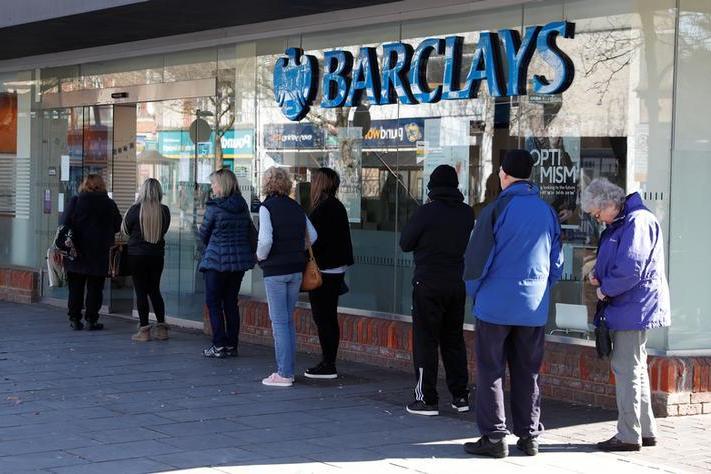More Layoffs In Store, Barclays Unveils Ambitious Cost-Saving Plan To Cut 2000 Jobs And Branch Closures in Strategic Overhaul
In a strategic move to bolster profitability, Barclays, under the leadership of CEO C.S. Venkatakrishnan, is planning a comprehensive cost-saving plan that could see up to £1 billion ($1.25 billion) in savings. However, it may involve reducing around 2,000 jobs, primarily within the bank's back-office functions, which is part of Venkat's broader efforts to enhance Barclays' book value and present a compelling strategy to investors. Concurrently, the bank is undertaking branch closures in alignment with its vision to reshape its physical presence amid the evolving landscape of banking preferences.

Barclays is developing a cost-saving plan aimed at achieving savings of up to £1 billion ($1.25 billion) that could potentially result in the reduction of approximately 2,000 jobs, primarily in the bank’s back-office functions.
The bank’s managers, led by CEO C.S. Venkatakrishnan (Venkat), are currently said to be evaluating proposals to enhance profitability, with the potential job cuts ranging from 1,500 to 2,000 if the plan is fully implemented, the source revealed.
The contemplated job reductions are expected to focus on Barclays Execution Services, internally referred to as ‘BX,’ forming part of a broader strategy to cut expenses by up to £1 billion across the organization over several years.
While Barclays has previously sought expense reductions by trimming bonuses and jobs in its retail and investment banking divisions, this move to downsize BX and achieve potential savings has not been reported before.

BX was established in 2017 to consolidate support functions for the bank’s main business divisions, UK retail banking and international; BX was designed to eliminate duplication and implement post-crisis risk management rules.
Barclays aims to achieve its £1 billion cost-saving target, representing around 7% of the bank’s underlying annual operating expenses of £15 billion in 2022.
The source noted that discussions on BX’s headcount are ongoing, and the bank may opt to prioritize layoffs in other areas. BX’s staffing and costs have seen significant growth in recent years, with its headcount reaching approximately 22,300 by the end of 2022, accounting for over a quarter of Barclays’ total staff.
Annual staff costs at BX have risen to £2 billion from £1.8 billion, and the CEO is facing pressure to enhance Barclays’ declining book value before an investor presentation in February where he will unveil a new strategy.

Since assuming the role of CEO, Venkat has dealt with the aftermath of a trading blunder that cost the bank hundreds of millions of dollars and is grappling with a talent exodus in Barclays’ investment bank, hindering competition with European rivals like Deutsche Bank, BNP Paribas, and UBS.
Barclays’ share price has declined by 26% since Venkat took charge in November 2021, in contrast to Deutsche Bank’s stable shares and HSBC’s 37% gain.
According to a second source within the division, actions are being taken across teams within BX, with effectively frozen budgets this year and a directive to reduce costs in 2024.
Venkat indicated on October 23 that Barclays would undergo further restructuring in preparation for the February 20 presentation, seen as a crucial opportunity for the bank to convince shareholders of its plan to boost its valuation.
Barclays is currently conducting a strategy review with Boston Consulting Group, focusing on which parts of the business to invest in and which to reduce or sell, which includes reviewing options for its payments business, among other measures, as reported in July.

Barclays To Close Branches
In a related move, Barclays is set to further reduce its physical presence by closing an additional 16 branches in the United Kingdom by March 2024, aligning with the bank’s overarching strategy to shutter nearly one-third of its branches within the next year due to a sustained decline in in-person visits.
Residents in affected areas, including Eltham, Cobham, and Liscard, are being encouraged to transition to online banking or explore alternative branches as part of the bank’s commitment to supporting customers during this transition, and the bank will facilitate this through its Barclays Local initiatives, offering flexible access to face-to-face banking services at pop-up sites in community centers and libraries.
To ensure uninterrupted access to essential banking services, Barclays plans to establish over 200 pop-up sites across the country, complementing traditional post office services and facilitating financial transactions such as deposits and withdrawals.
In addition to providing alternative banking solutions, Barclays is actively prioritizing assistance for customers adapting to digital platforms. The bank is extending its efforts by organizing digital skills workshops and events aimed at raising awareness about fraud and scams. These initiatives are designed to educate customers on securely managing their financial needs in an increasingly digital environment.

This recent announcement follows a prior report, shedding light on Barclays’ planned closures and their potential impact on communities. Customers in areas like Farnham are advised to prepare for these changes by exploring online banking options or seeking face-to-face assistance at remaining branches or through Barclays Local services.
While specific closures, such as those in Dereham and South Woodford, were mentioned in the earlier report without an official statement from Barclays, the bank has assured customers that services will remain accessible at post offices. Notably, the closure of Wallasey’s branch is confirmed, scheduled to cease operations by March 28, 2024
Global Economic Slowdown Triggers Wave of Layoffs, Especially in Banking Sector
The global economy is experiencing a pronounced slowdown, and its reverberations are felt acutely in the job market, with a surge in layoffs, particularly within the banking sector.
As economic uncertainties persist, financial institutions are grappling with the need to streamline operations and reduce costs, leading to a wave of job cuts that extends across borders.
The current economic slowdown has significantly impacted the banking industry, a cornerstone of the global economy. Facing reduced consumer spending, lower investment activity, and an overall downturn in financial markets, banks are compelled to reevaluate their operational structures to navigate the challenging economic scenario.
In recent months, major banks worldwide have announced substantial layoffs as part of their strategic responses to mitigate financial pressures. Institutions are adopting cost-cutting measures to safeguard their financial health, and unfortunately, this often translates into workforce reductions.

The banking layoffs are not limited to a specific region; rather, they span the globe. From North America to Europe, Asia, and beyond, financial institutions are making tough decisions to align their workforce with the current economic reality. The layoffs are occurring not only in customer-facing roles but also in support functions and back-office operations.
The financial sector’s downsizing is multifaceted, driven by factors such as shrinking profit margins, increased regulatory pressures, and the imperative to invest in technology to stay competitive in an evolving financial domain. These dynamics contribute to an environment where job security becomes increasingly precarious for many in the industry.
Impact on Employees and Communities
The spate of global layoffs in the banking sector has profound consequences for affected employees and their communities. Beyond the immediate financial impact on those losing their jobs, the psychological toll is substantial. Moreover, the ripple effect extends to local economies, as reduced consumer spending and a weakened job market can contribute to a broader economic downturn.
As banks grapple with the need to innovate and adapt to the changing economic climate, the challenge lies in striking a balance between cost-cutting measures and maintaining a responsible approach to their workforce has become increasingly challenging.
The Last Bit, Barclays’ dual strategy of substantial cost-cutting and branch closures signifies a comprehensive effort to reshape its operational ecosystem.
As the bank aims to navigate a complex financial environment and enhance shareholder value, the upcoming investor presentation in February will be critical.




